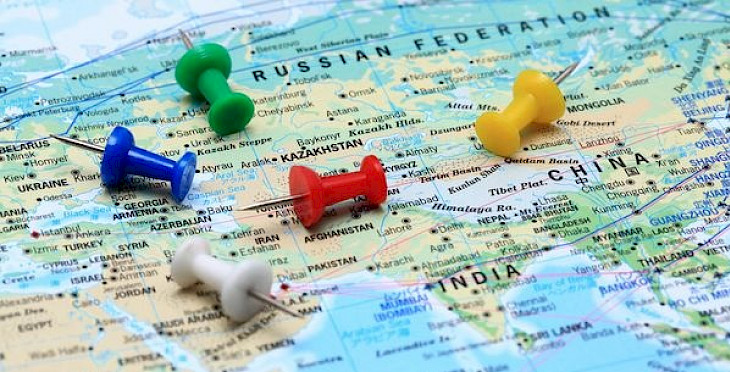Central Asia is finding itself at the center of a global geopolitical fracture. On one side is China's growing influence through large-scale economic expansion and its Belt and Road Initiative. On the other are the strategic interests of Russia and the United States, viewed differently by regional elites. Some seek balance, others look for salvation, and a few aim for independence, according to a feature by Eurasiatoday.ru.
What lies ahead for Kazakhstan and its neighbors in the coming years?
Can they maintain sovereignty, or are they destined to become the battleground of a renewed great-power rivalry?
These questions were tackled in a new episode of Oshakbaev LIVE, a Kazakhstani talk show hosted by Rakhim Oshakbaev. Guest speaker Maxim Shevchenko—a Russian journalist, politician, publicist, and leader of the Freedom and Justice Party—unpacked the deeper motivations of global players, discussed why the West is losing its cultural identity, the role of the Vatican in geopolitics, and how spiritual and cultural meanings are increasingly used as tools in global power plays.
This conversation is more than political analysis—it's a reflection on an era in which Central Asia is no longer peripheral, but once again becoming a global axis.
“Central Asia today isn’t just a crossroads of interests. It’s a geopolitical chessboard where powers place their bets—but history makes the moves,” said Shevchenko.
Who Holds the Cards?
Central Asia, once the stage of the Great Geographic Discoveries, has now become a theater of rivalry among modern empires—China, Russia, and the United States.
Moscow maintains its foothold through military and cultural ties. Beijing builds influence through loans, infrastructure, and electricity. Washington takes a subtler route: NGOs, academic programs, elite engagement, and soft power.
“Central Asia is not an object but a potential subject of history,” Shevchenko argues. “But to become a subject, it must step out of the shadow of foreign ambitions.”
China: Silk, Not Tanks
China has approached the region not with weapons but with infrastructure—building roads, railways, and investing in energy and digital networks. The Belt and Road Initiative has already redrawn the map of Central Asia.
“China isn’t invading—it’s weaving itself into the economic fabric. This isn’t expansion, it’s dependency by design,” Shevchenko said.
According to ADB and UNESCAP, Chinese investment in the region has already exceeded $60 billion. But what is the cost? Kazakhstani analyst Rakhim Oshakbaev explains:
“It’s convenient—but not sovereign. We are trading growth for dependence.”
Russia: Memory or Strategy?
Russia still sees the region as part of its sphere of influence. Military bases, the CSTO, the Eurasian Economic Union, migration flows, and language policy are all tools of continued control. However, younger generations are increasingly detached from any Soviet nostalgia.
“Russia is trying to hold the region not with a vision of the future, but with memories of the past. It’s a strategy of retention, not development,” says Shevchenko.
At the same time, Russia remains the region’s largest trading partner and top labor market, with over 4 million Central Asian migrant workers residing in the country.
The United States: Unseen but Persistent
The U.S. strategy is a long-term “shadow game”: investing in education, civil society, media support, democracy, and human rights. But it’s also expanding in security—joint military exercises, border control projects, intelligence, and cybersecurity initiatives.
“The U.S. isn’t colonizing—it’s rewriting. Its bets are on the elites and cultural transformation,” one commentator noted.
During a 2023 visit that sparked mixed reactions, U.S. Secretary of State Antony Blinken stated:
“Central Asia deserves sovereignty without fear, and development without dependency.”
Who Has the Winning Hand?
Central Asian countries now maneuver between three centers of power. Kazakhstan pursues a multi-vector foreign policy. Uzbekistan focuses on internal modernization. Kyrgyzstan and Tajikistan grapple with instability, while Turkmenistan maintains strict isolation.
But regardless of the regional mosaic, the geopolitical reality is clear: the region teeters on the fault line between empires and must chart its own path to survival.
Breaking the Trap
“If Central Asia doesn’t become a source of its own identity and strategic vision, it will forever remain a buffer zone for other interests,” Shevchenko warns.
His proposal: to create a regional philosophy of integration—one that doesn’t pit identities against each other, but synthesizes Turkic, Persian, Soviet, Islamic, and modern digital elements.
Conclusion: Who Wins in This Triangle?
Sustainable development in Central Asia is possible only if the region stops being a playing field and becomes a player. This requires institutions, a sovereign strategy, and an intellectual elite capable of thinking beyond the clichés of geopolitical dependency.
CentralasianLIGHT.org
May 12, 2025

